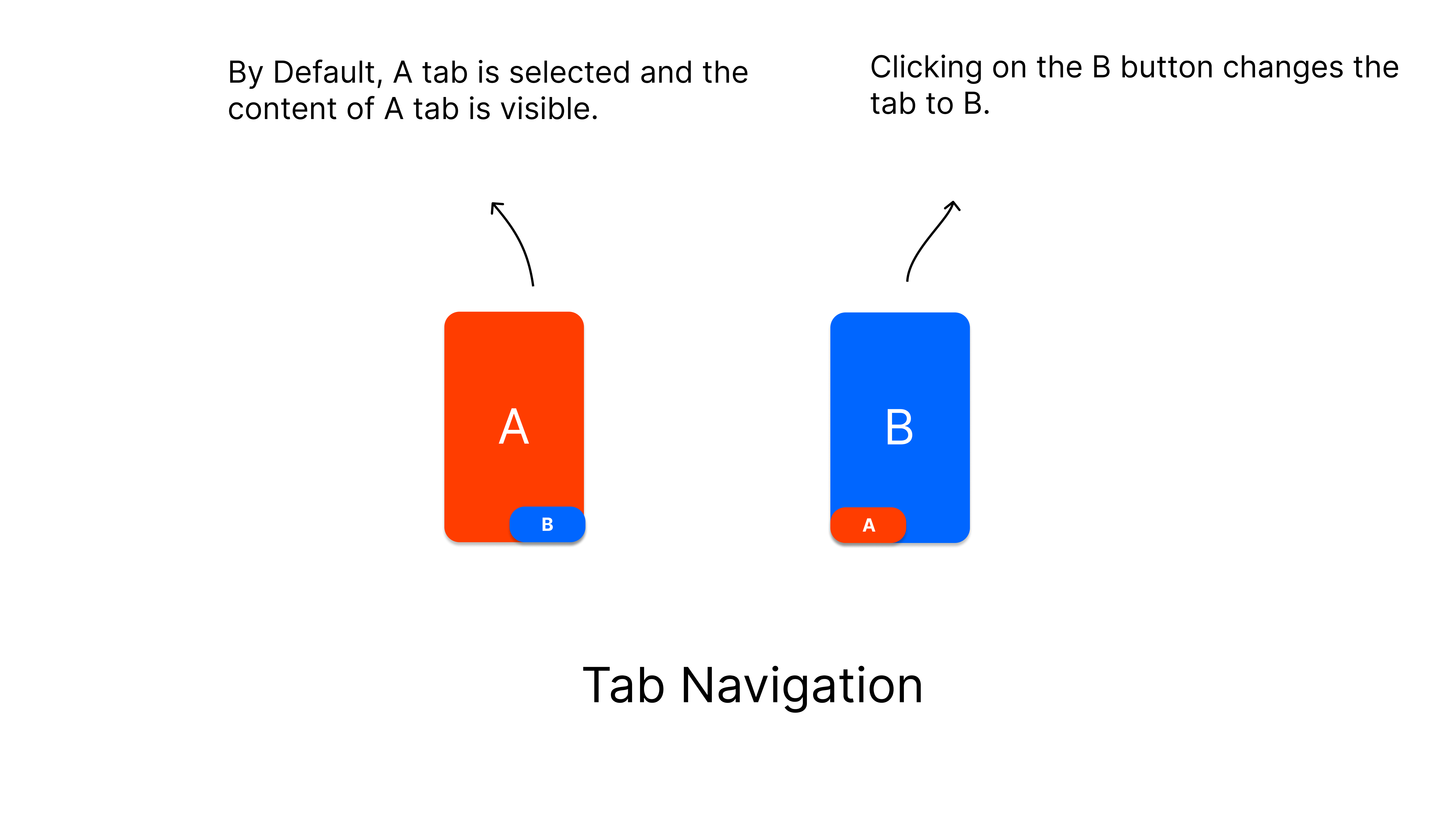Introduction to React Native Navigation
In this article, we are going to learn how we can implement navigation in React Native. We are going to use React Navigation which is the official library for adding routing and navigation to React Native applications. We are going to discuss the following types of Navigation and how to implement them:
- Stack Navigation
- Tab Navigation
- Drawer Navigation
Prerequisites
Basics of React

Stack Navigation In this kind of navigation, a stack of screens is maintained. Each time we visit a screen, it is pushed to the stack, and pressing back will pop the item from the stack and show the last screen. A good example of this type of navigation is web pages where we navigate between different pages of a site and press back to move to the last page. Before we proceed, we need to add the library needed for Stack navigation.
npm install @react-navigation/native-stackHow we can create screens?
To add screens available to be navigated through in the application, we need to create a basic structure as given in the code example below which includes initializing the Stack navigator with createNativeStackNavigator() and using it inside the NavigationContainer.
import * as React from 'react';
import { Text } from 'react-native';
// Imports related to navigation
import {NavigationContainer} from '@react-navigation/native';
import {createNativeStackNavigator} from '@react-navigation/native-stack';
// Initialize the Stack navigator
const Stack = createNativeStackNavigator();
// We always surround navigator with NavigationContainer
function StackNavigation() {
return (
<NavigationContainer>
<Stack.Navigator>
{/* Add your screens here */}
</Stack.Navigator>
</NavigationContainer>
);
}
export default StackNavigation;Inside <Stack.Navigator> is the place where we need to place all our screens. Each screen goes with <Stack.Screen> tag and we will pass two props name and component, where name is the name of the component, make sure that it is unique and avoid using special characters and spaces and component is the component we want to add as the screen. Below given is a code with two screens added. By default, the screen which comes first inside <Stack.Navigator> will be visible first to the user or in other words it will be the screen that will be pushed there in the stack already, for example in the below code Screen1 will be visible.
Tip: We can also use
initialRouteNameprop onStack.Navigatorto specify the default screen too.
import * as React from 'react';
import {Text} from 'react-native';
import {NavigationContainer} from '@react-navigation/native';
import {createNativeStackNavigator} from '@react-navigation/native-stack';
// Our Screens
function Screen1() {
return <Text>Screen 1</Text>;
}
function Screen2() {
return <Text>Screen 2</Text>;
}
// Initialize the Stack navigator
const Stack = createNativeStackNavigator();
function StackNavigation() {
return (
<NavigationContainer>
<Stack.Navigator>
<Stack.Screen name="Screen1" component={Screen1} />
<Stack.Screen name="Screen2" component={Screen2} />
</Stack.Navigator>
</NavigationContainer>
);
}
export default StackNavigation;The application right now looks like the image given below where we see our default screen (Screen1) and currently there is no way to navigate to Screen2. We will talk about how to do that in the below section.

How we can travel between screens?
Now that we have two screens in our application. Let’s see how we can move between these screens or we can say how we can push new screens to the stack. React Navigation comes with a method to achieve this called navigate() which is available in the navigation prop, this prop is added automatically for each screen. In navigate() method, we just need to pass the name of the screen we want to navigate to. This name is the same name that we set in the previous section. Let’s see a code example, where we have a button in Screen1 to navigate to Screen2 and a button in the latter to navigate to the former.
import * as React from 'react';
import {Text, Button} from 'react-native';
import {NavigationContainer} from '@react-navigation/native';
import {createNativeStackNavigator} from '@react-navigation/native-stack';
// Our Screens
function Screen1({navigation}) {
return (
<>
<Text>Screen 1</Text>
<Button
title="Go to Screen 2"
onPress={() => navigation.navigate('Screen2')}
/>
</>
);
}
function Screen2({navigation}) {
return (
<>
<Text>Screen 2</Text>
<Button
title="Go to Screen 1"
onPress={() => navigation.navigate('Screen1')}
/>
</>
);
}
// Initialize the Stack navigator
const Stack = createNativeStackNavigator();
function StackNavigation() {
return (
<NavigationContainer>
<Stack.Navigator>
<Stack.Screen name="Screen1" component={Screen1} />
<Stack.Screen name="Screen2" component={Screen2} />
</Stack.Navigator>
</NavigationContainer>
);
}
export default StackNavigation;
You can see that clicking on Go to Screen 2 takes us to Screen2 and further, there is a back button available in the upper left section in Screen2 to go back. Go to Screen 1 button in Screen2 takes us back to Screen1 and behaves the same as pressing the back button, this is being handled by React Navigation Library. Instead of pushing new Screen1 to stack, it is looking back in the history of the stack to navigate to the required page if found. Further in a similar fashion, if the page to navigate to is in the stack already, it will keep popping the stack until it reaches that page. If your requirement is to create new screens and push to stack instead of looking back in the history stack, use navigation.push("name") instead of navigation.navigate("name") .
Note: React Navigation provides two types of Stack Navigator API, we are using Native Stack instead of Stack, because former uses native navigation primitives to provide better performance. If you want more customizability go with the latter.

Another commonly used navigation style is having tabs on the page and navigating to and fro. Tabs can be either on the top of the screen or bottom. React navigation comes with three different APIs for tabs:
Bottom Tabs A simple tab bar on the bottom of the screen.
Material Bottom Tabs A material-design-themed tab bar on the bottom of the screen.
Material Top Tabs A material-design-themed tab bar on the top of the screen.
In this article, we are only going to look at Bottom Tabs to get an idea of how to use a tab navigator. Start with installing the required package for Bottom Tabs:
npm install @react-navigation/bottom-tabsJust like Stack Navigation, we have to follow a structure as given in the sample code below. We have to initialize the navigator using createBottomTabNavigator() and then use it inside NavigationContainer as given in the example, all the tab screens go inside Tab.Navigator.
import * as React from 'react';
import { Text } from 'react-native';
// Imports related to navigation
import {NavigationContainer} from '@react-navigation/native';
import { createBottomTabNavigator } from '@react-navigation/bottom-tabs';
// Initialize the Tab navigator
const Tab = createBottomTabNavigator();
// We always surround navigator with NavigationContainer
function TabsNavigation() {
return (
<NavigationContainer>
<Tab.Navigator>
{/* Add your tab components here */}
</Tab.Navigator>
</NavigationContainer>
);
}
export default TabsNavigation;Let’s create simple components for our tabs, Tab1 and Tab2 each of which needs to be inside <Tab.Navigator> element. We need to create each tab with Tab.Screen and pass name and component in a similar fashion as done in the Stack example.
You can also use
navigation.navigate()method in a similar fashion as done in Stack Navigator.
import * as React from 'react';
import {Text} from 'react-native';
import {NavigationContainer} from '@react-navigation/native';
import {createBottomTabNavigator} from '@react-navigation/bottom-tabs';
// Our Tabs
function Tab1() {
return <Text>Tab 1</Text>;
}
function Tab2() {
return <Text>Tab 2</Text>;
}
// Initialize the Tab navigator
const Tab = createBottomTabNavigator();
// We always surround navigator with NavigationContainer
function TabsNavigation() {
return (
<NavigationContainer>
<Tab.Navigator>
<Tab.Screen name="Tab1" component={Tab1} />
<Tab.Screen name="Tab2" component={Tab2} />
</Tab.Navigator>
</NavigationContainer>
);
}
export default TabsNavigation;Let’s see an animation of how our project looks with current code changes. Clicking on tab names on the button should change the rendered component as given in the animation below.

You can also customize the icon of each Tab using
tabBarIconkey on the options prop on eachTab.Screen,or by passingtabBarIconto screenOptions onTab.Navigator, to keep code example simple I leave that exploration up to you.

Drawer can be said to be a special type of Tab where the buttons to change the tab live in a drawer on the left side (or right). To use a drawer in the project, start with installing the dependency.
npm install @react-navigation/drawerFurther, to complete the setup follow the instructions given here. It is advised to run pod install inside ios folder after doing all the dependencies installation.
Just like other navigators already discussed previously, Drawer also has a similar structure to be followed. We use createDrawerNavigator() to initialize the navigator and use it inside <NavigationContainer> as given in the code example below.
import * as React from 'react';
import { Text } from 'react-native';
// Imports related to navigation
import {NavigationContainer} from '@react-navigation/native';
import {createDrawerNavigator} from '@react-navigation/drawer';
// Initialize the Drawer navigator
const Drawer = createDrawerNavigator();
// We always surround navigator with NavigationContainer
function DrawerNavigation() {
return (
<NavigationContainer>
<Drawer.Navigator>
{/* Add your Drawer components here */}
</Drawer.Navigator>
</NavigationContainer>
);
}
export default DrawerNavigation;In a similar fashion, we will use Drawer.Navigator to place all our different screen/Drawer components. Now let’s see a full-fledged drawer with three screens. Each screen will go with Drawer.Screen with name and component props. On each screen, we also have a link to navigate between them, or alternatively, we can use the drawer to change screens. Below given are the code and the output.
import 'react-native-gesture-handler';
import * as React from 'react';
import {Text, Button} from 'react-native';
import {NavigationContainer} from '@react-navigation/native';
import {createDrawerNavigator} from '@react-navigation/drawer';
// Our Screens
function Screen1({navigation}) {
return (
<>
<Text>Screen 1</Text>
<Button
title="Go to Screen 2"
onPress={() => navigation.navigate('Screen2')}
/>
</>
);
}
function Screen2({navigation}) {
return (
<>
<Text>Screen 2</Text>
<Button
title="Go to Screen 3"
onPress={() => navigation.navigate('Screen3')}
/>
</>
);
}
function Screen3({navigation}) {
return (
<>
<Text>Screen 3</Text>
<Button
title="Go to Screen 1"
onPress={() => navigation.navigate('Screen1')}
/>
</>
);
}
// Initialize the Drawer navigator
const Drawer = createDrawerNavigator();
function DrawerNavigation() {
return (
<>
<NavigationContainer>
<Drawer.Navigator>
<Drawer.Screen name="Screen1" component={Screen1} />
<Drawer.Screen name="Screen2" component={Screen2} />
<Drawer.Screen name="Screen3" component={Screen3} />
</Drawer.Navigator>
</NavigationContainer>
<NavigationContainer />
</>
);
}
export default DrawerNavigation;
JavaScript, Mobile App Development, React Native, ReactJS — Sep 4, 2022
Made with ❤ at Earth.